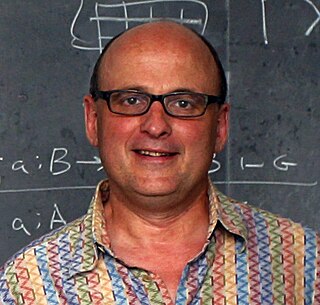
In computer science, garbage collection (GC) is a form of automatic memory management. The garbage collector attempts to reclaim memory that was allocated by the program, but is no longer referenced; such memory is called garbage. Garbage collection was invented by American computer scientist John McCarthy around 1959 to simplify manual memory management in Lisp.
In computer science, reference counting is a programming technique of storing the number of references, pointers, or handles to a resource, such as an object, a block of memory, disk space, and others.
In computing, a virtual machine (VM) is the virtualization or emulation of a computer system. Virtual machines are based on computer architectures and provide the functionality of a physical computer. Their implementations may involve specialized hardware, software, or a combination of the two. Virtual machines differ and are organized by their function, shown here:
SIGPLAN is the Association for Computing Machinery's Special Interest Group on programming languages.
Henry Givens Baker Jr. is an American computer scientist who has made contributions in garbage collection, functional programming languages, and linear logic. He was one of the founders of Symbolics, a company that designed and manufactured a line of Lisp machines. In 2006 he was recognized as a Distinguished Scientist by the Association for Computing Machinery.
In software engineering, profiling is a form of dynamic program analysis that measures, for example, the space (memory) or time complexity of a program, the usage of particular instructions, or the frequency and duration of function calls. Most commonly, profiling information serves to aid program optimization, and more specifically, performance engineering.

Robert William "Bob" Harper, Jr. is a computer science professor at Carnegie Mellon University who works in programming language research. Prior to his position at Carnegie Mellon, Harper was a research fellow at the University of Edinburgh.
The annual ACM SIGPLAN-SIGACT Symposium on Principles of Programming Languages (POPL) is an academic conference in the field of computer science, with focus on fundamental principles in the design, definition, analysis, and implementation of programming languages, programming systems, and programming interfaces. The venue is jointly sponsored by two Special Interest Groups of the Association for Computing Machinery: SIGPLAN and SIGACT.
In computer science, pointer analysis, or points-to analysis, is a static code analysis technique that establishes which pointers, or heap references, can point to which variables, or storage locations. It is often a component of more complex analyses such as escape analysis. A closely related technique is shape analysis.
In proof theory, the Geometry of Interaction (GoI) was introduced by Jean-Yves Girard shortly after his work on linear logic. In linear logic, proofs can be seen as various kinds of networks as opposed to the flat tree structures of sequent calculus. To distinguish the real proof nets from all the possible networks, Girard devised a criterion involving trips in the network. Trips can in fact be seen as some kind of operator acting on the proof. Drawing from this observation, Girard described directly this operator from the proof and has given a formula, the so-called execution formula, encoding the process of cut elimination at the level of operators.
In computer science, capability-based addressing is a scheme used by some computers to control access to memory as an efficient implementation of capability-based security. Under a capability-based addressing scheme, pointers are replaced by protected objects which specify both a location in memory, along with access rights which define the set of operations which can be carried out on the memory location. Capabilities can only be created or modified through the use of privileged instructions which may be executed only by either the kernel or some other privileged process authorised to do so. Thus, a kernel can limit application code and other subsystems access to the minimum necessary portions of memory, without the need to use separate address spaces and therefore require a context switch when an access occurs.
Matthew Flatt is an American computer scientist and professor at the University of Utah School of Computing in Salt Lake City. He is also the leader of the core development team for the Racket programming language.
Hermes is a language for distributed programming that was developed at IBM's Thomas J. Watson Research Center from 1986 through 1992, with an open-source compiler and run-time system. Hermes' primary features included:
In type theory, a refinement type is a type endowed with a predicate which is assumed to hold for any element of the refined type. Refinement types can express preconditions when used as function arguments or postconditions when used as return types: for instance, the type of a function which accepts natural numbers and returns natural numbers greater than 5 may be written as . Refinement types are thus related to behavioral subtyping.
In computer science, region-based memory management is a type of memory management in which each allocated object is assigned to a region. A region, also called a zone, arena, area, or memory context, is a collection of allocated objects that can be efficiently reallocated or deallocated all at once. Memory allocators using region-based managements are often called area allocators, and when they work by only "bumping" a single pointer, as bump allocators.

Kathryn S. McKinley is an American computer scientist noted for her research on compilers, runtime systems, and computer architecture. She is also known for her leadership in broadening participation in computing. McKinley was co-chair of CRA-W from 2011 to 2014.
Trellis/Owl, or simply Owl, is a defunct object-oriented programming language created by Digital Equipment Corporation. It was part of a programming environment, Trellis. It ran on the OpenVMS operating system.

David A. Moon is a programmer and computer scientist, known for his work on the Lisp programming language, as co-author of the Emacs text editor, as the inventor of ephemeral garbage collection, and as one of the designers of the Dylan programming language. Guy L. Steele Jr. and Richard P. Gabriel (1993) name him as a leader of the Common Lisp movement and describe him as "a seductively powerful thinker, quiet and often insulting, whose arguments are almost impossible to refute".
Ilya Sergey is a Russian computer scientist and an Associate Professor at the School of Computing at the National University of Singapore, where he leads the Verified Systems Engineering lab. Sergey does research in programming language design and implementation, software verification, distributed systems, program synthesis, and program repair. He is known for designing the Scilla programming language for smart contracts. He is the author of the free online book Programs and Proofs: Mechanizing Mathematics with Dependent Types, Lecture notes with exercises, which introduce the basic concepts of mechanized reasoning and interactive theorem proving using Coq.



